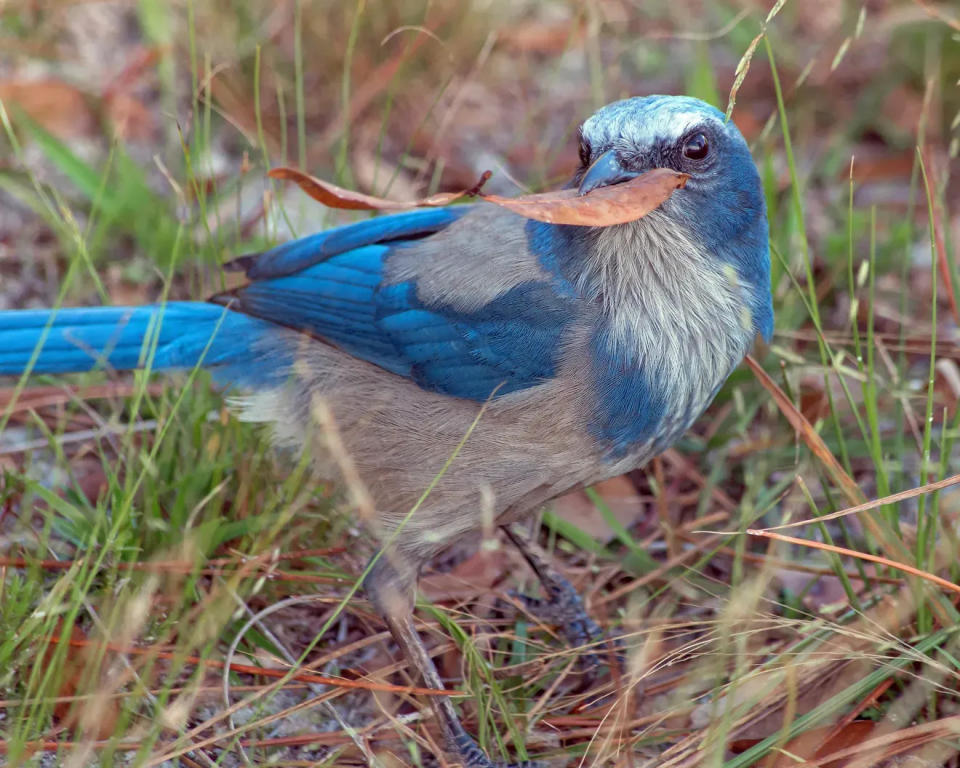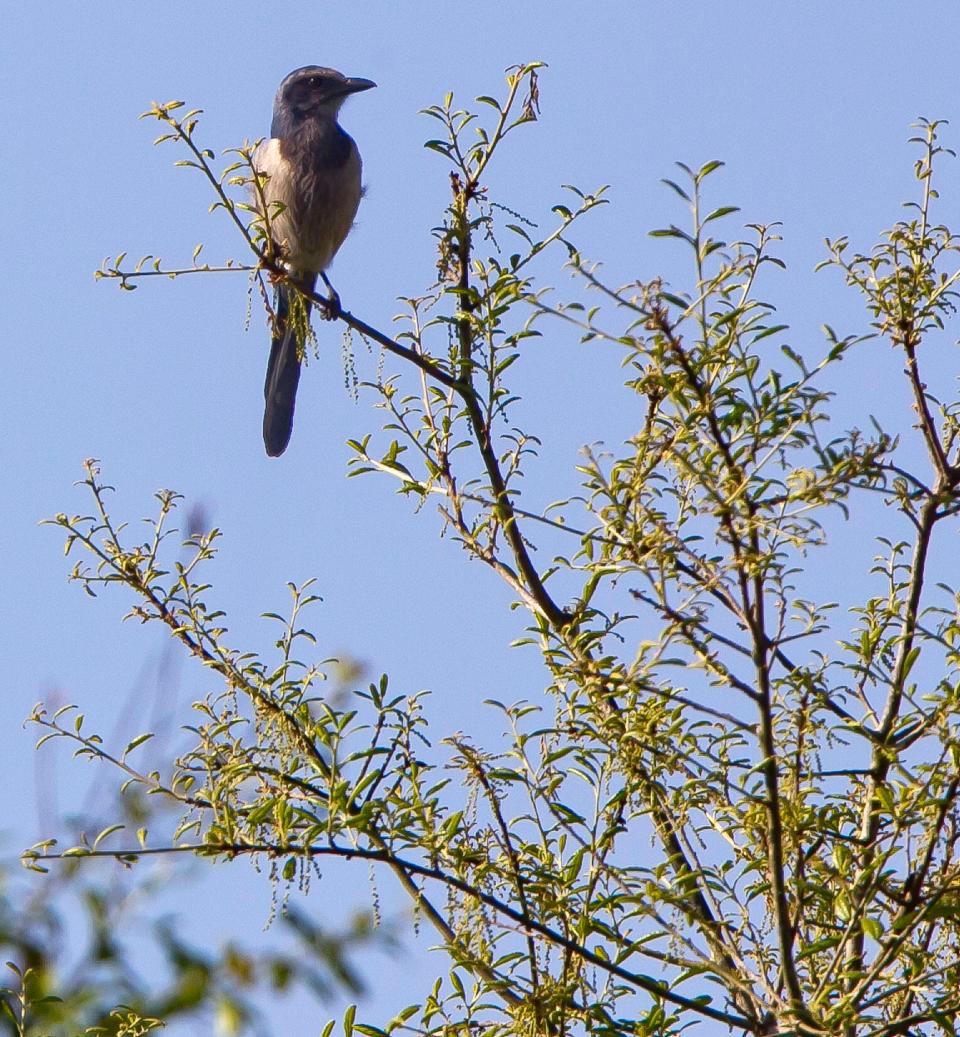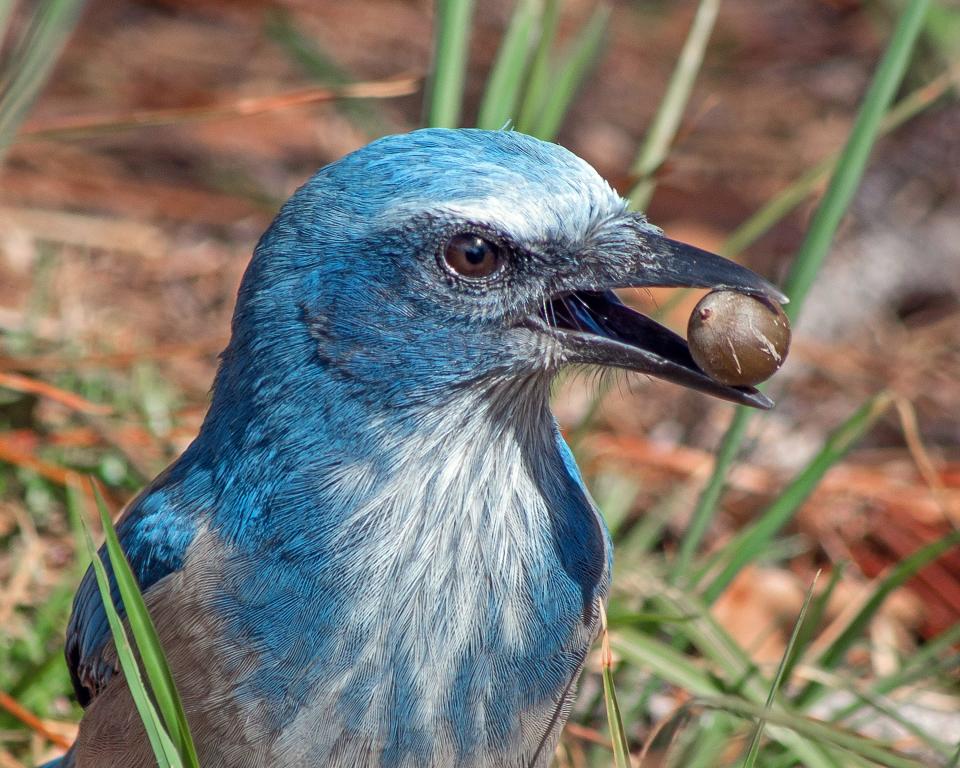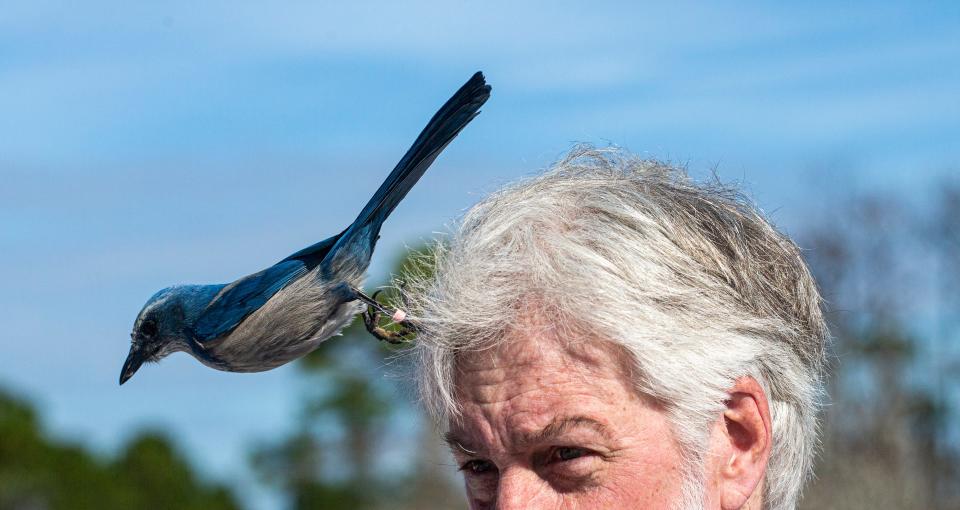Florida scrub jay: Threatened, politically controversial and possibly the first snowbird
The Florida scrub jay is like a lot of Floridians; the bold bird with a bright sky-blue head and grey underbelly is descended from tourists who never left, and seemingly just wanders into political controversies.
The scrub jay is not the biggest of birds; it weighs about 2.3 ounces and is 10 inches in length, but it is one of 89 birds listed as either threatened or endangered under the U.S. Endangered Species Act, enacted 50 years ago this December.
And the Florida scrub jay can proudly crow its forefathers were among the first snowbirds to visit the Sunshine State. (Scrub jays don't sing, they screech. Search Florida scrub jay at allaboutbirds.org to hear its call.)

Its long-term residency, and penchant to eat out of people’s hands, and to live in family-like clans has led scrub jay fans to try to have it designated the official state bird five times in the past 24 years.
Their most notable opponent was a now-retired legendary lobbyist for the National Rifle Association, who vehemently shot down the initial campaign to promote the scrub jay as a family-friendly bird.
When a proposal was debated in a 1999 House committee meeting, Marion Hammer harshly criticized the effort to strip state bird designation from the northern mockingbird, which possesses a repertoire of 200 songs. She accused the scrub jay of criminal conduct and a lifestyle that undermines family values.
“Scrub jays are so lazy and scurrilous they eat the eggs and nestlings of other birds. Now to me, that's robbery and murder and those are not good family values. And you certainly can't call that friendly. That's not the image we want for our state,” said Hammer.
She told lawmakers what others described as the bird's friendliness was actually "begging," and signs of a “welfare mentality.”
The first Florida scrub jays
About 2 million years ago, sea levels dropped, and a corridor opened across the Gulf of Mexico for birds and animals to disperse. The California scrub jay colonized the sandy ridges of Florida's central highlands, a geological feature similar to the oak flatlands of the southwest and found nowhere else in the Southeast U.S.
“If you ever watched old western movies, some of the landscape in those films is a lot like habitat in parts of Florida. You can film parts of Florida and think you were in Texas,” said Mark Jerome Walters, author of The Florida Scrub Jay: Field Notes of a Vanishing Bird.

When the Ice Age ended and sea levels rose, the scrub jay was cut off from its ancestral home out west. Over hundreds of thousands of years, what was a California scrub jay evolved into a distinctive species now known as the Florida scrub jay, endemic to Florida.
The Florida scrub jay lacks a grey band on its back that the California jay has, has more blue coloring and a white frosting on its head, which the California jay lacks. Also, the Florida scrub jay covers a much smaller territory than its western cousin. It never leaves Florida, while the California scrub jay ranges from British Columbia south along the Pacific Coast and east into Nevada.
Lost lands and dwindling population
Florida’s development in the 20th century encroached on much of the scrub jay’s habitat in two successive waves.
First orange groves were cultivated on the sandy ridges where the bird buries acorns and lives among the stunted oak trees (6.5 feet tall or less) and shrubs. Scrub jays rarely wander from the open sandy patches where they hatched.
And when agriculture was through with the land, the groves were replaced with cities and subdivisions.

“That was the historical succession that occurred all around the state, destroying scrub jay habitat until the birds and other species that rely on scrub have been eliminated,” said Walters, who teaches journalism at the University of South Florida.
He finds it ironic that the scrub jay, a native Floridian, was pushed aside to grow citrus, a non-native fruit.
“This orange that many people see as pure Florida actually led to the destruction of the only true native bird,” said Walters.
Conservation effort derailed by gun and property rights
Today there are an estimated 9,000 individual scrub jays nesting in 57 counties, according to the Florida Fish and Wildlife Commission. That count is down from nearly 50,000 in the late 1800s – according to Audubon Florida.
The scrub jay was listed as a Threatened species by the federal Endangered Species Act in 1987, and over the next decade Florida birders, environmentalists, and school children rallied to have its uniqueness recognized with a state bird designation.
The ad hoc alliance lobbied county commissions to support the initiative and submitted petitions signed by school children to the Legislature.
A bipartisan bill emerged and when the House Government Operations Committee heard it, Hammer derided the campaign as a “sneaky way” by environmentalists to get money for land acquisition and to gut private property rights.

Hammer read excerpts from local newspaper accounts of scrub jay supporters' discussions with the Martin, St. Lucie and Brevard County commissions to argue the scrub jay was being used as a pawn to secure tax dollars to buy up land for conservation and block development.
“After all, how could you not appropriate millions of dollars from the state treasury to save the state bird,” said Hammer.
She told committee members whenever the scrub jay is mentioned, talk about protection of its habitat seemingly always followed.
“If you vote to make the Scrub Jay the state bird, that could be all the feds are waiting for to move it up from the Threatened List to the Endangered Species List. And once that happens, you can kiss your property rights good-bye in the central Florida area,” said Hammer.

The House committee voted down the measure.
An identical measure died in the Senate.
After the dust cleared, the now-defunct Tampa Tribune editorialized that Hammer was hostile to the proposal because an Audubon Society representative on the Constitution Revision Commission had endorsed a gun control amendment.
Bills filed in 2000, 2016, 2022, and 2023, were never scheduled for a committee hearing.
Hammer retired in 2022.
Last month, Sen. Tina Polsky, D-Fort Lauderdale filed SB 162 in another attempt to have the Florida scrub jay designated the official state bird of Florida.
She said the scrub jay is a bird all Floridians can be proud of and that it represents "the enchanting nature of Florida."
SB 162 has yet to be scheduled for a committee hearing. The 2024 session of the Florida Legislature convenes Jan. 9.
James Call is a member of the USA TODAY NETWORK-Florida Capital Bureau. He can be reached at jcall@tallahassee.com and is on X as @CallTallahassee
This article originally appeared on Tallahassee Democrat: Threatened scrub jay controversy rooted in Florida tourism and guns

